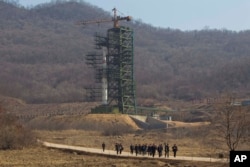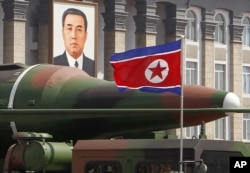When North Korea notified international organizations of its plan to launch a long-range rocket this month, it said the move is part of its "space development program."
The communist country said Tuesday that it plans to "launch Earth observation satellite Kwangmyongsong pursuant to the national space development program" in a letter sent to the U.N.'s International Maritime Organization (IMO) this week.
The announcement is raising concerns in the United States and neighboring countries that the planned launch is a cover for a test of a long-range missile.
"Given North Korea's openly stated intention of pursuing the development of its nuclear and ballistic missile programs, any satellite launch can only be viewed as furthering the development of these programs," Francois Lasalle, a spokesperson for Canada's Foreign Ministry, told VOA by email.
Extended range
Pyongyang's last long-range rocket launch showed that the country had made some progress in its effort to extend the range of its rocket.
"Initial indications are that the missile deployed an object that appeared to achieve orbit. At no time was the missile or the resultant debris a threat to North America," said the North American Aerospace Defense Command in a statement after Pyongyang fired a long-range rocket in December 2012.
U.S. military analysts say Washington's primary concern is whether Pyongyang has the capability to fire an intercontinental ballistic missile (ICBM) that could reach the U.S. mainland.
"Our assessment is that they have the ability to put a nuclear weapon on a KN-08 and shoot it at the homeland," Admiral William Gortney, commander of the U.S. Northern Command, told reporters in April 2015, referring to North Korea's new road-mobile missile.
U.S. officials say Pyongyang has not yet tested the missile believed to be an ICBM.
Many analysts, however, remain doubtful that Pyongyang has such a missile.
Joseph Bermudez, a chief analytical officer at AllSource Analysis, says Pyongyang lacks a proven capability to miniaturize a nuclear bomb that could fit atop an ICBM.
"If you look at the state of their technology, they should in theory be able to do it. Whether they can is a different story all together. We simply don't know at this point," Bermudez said.
Bermudez said Pyongyang may need more tests to possess full ICBM capability.
ICBM accuracy unclear
Jonathan McDowell at the Harvard-Smithsonian Center for Astrophysics said Pyongyang might have improved the capability to guide a missile to its target since the test in 2012. The newly announced launch plan calls for areas where a rocket is expected to fall to be smaller than those of the previous test, according to the astrophysicist.
"It may be they think they've tuned the guidance system a bit so that it's a bit more accurate," McDowell said.
Despite the apparent improvement, it appears North Korea has not acquired re-entry vehicle technology to deliver a weapon from space through the atmosphere to detonate, another hurdle for Pyongyang in its pursuit of the long-range missile.
"The missiles that North Koreans have right now entered the earth atmosphere quite fast, but not nearly as fast as a long-range intercontinental missile would do," McDowell said.
Bruce Bechtol, an associate professor at Angelo State University in Texas, warned that Pyongyang might have already acquired the re-entry vehicle technology, given that it has conducted tests of short- and medium-range missiles multiple times.
Rising tensions
On Thursday, South Korea and Japan said they will shoot down any debris that falls on their soils from a long-range rocket that North Korea plans to fire. South Korea's Defense Ministry said North Korea appears to be preparing the launch at its west coast launch site.
Pyongyang told the IMO that it will conduct the launch between February 8 and 25. The move follows the country's fourth nuclear test last month.
Washington condemned the plan, calling it "another destabilizing provocation on the part of North Koreans."
U.N. sanctions ban the North from conducting nuclear tests or any launches using ballistic missile technology.















